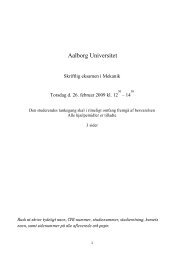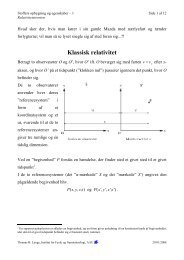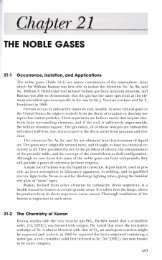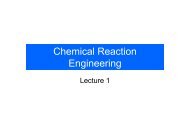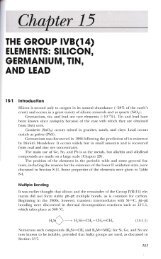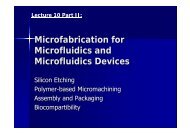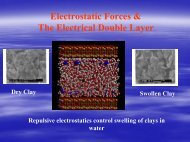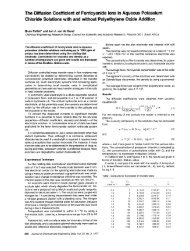Chapter 17 THE GROUP VB(15) ELEMENTS
Chapter 17 THE GROUP VB(15) ELEMENTS
Chapter 17 THE GROUP VB(15) ELEMENTS
Create successful ePaper yourself
Turn your PDF publications into a flip-book with our unique Google optimized e-Paper software.
<strong>Chapter</strong> <strong>17</strong><strong>THE</strong> <strong>GROUP</strong> <strong>VB</strong>(<strong>15</strong>)<strong>ELEMENTS</strong>: PHOSPHORUS,ARSENIC, ANTIMONY,AND BISMUTH<strong>17</strong>-1 IntroductionPhosphorus occurs mainly in minerals of the apatite family, Ca9(P04)6·CaX2;X = F, CI, or OH, which are the main components of amorphous phosphate rock,millions of tons of which are processed annually. The elements As, Sb, and Bioccur mainly as sulfide minerals, such as mispickel (FeAsS) or stibnite (Sb2Ss).Some properties of the elements are given in Table 8-5, and some generalfeatures and trends are noted in <strong>Chapter</strong> 8.The valence shells of the atoms (ns 2 nps) are similar to the electron configurationof N, but beyond the similarity in stoichiometries of compounds such asH s and PHs, there is little resemblance in the chemistry between even P andN. Phosphorus is a true nonmetal in its chemistry but As, Sb, and Bi show an increasingtrend to metallic character and cationic behavior.The principal factors responsible for the differences between nitrogen andphosphorus group chemistry are those responsible for the C to Si differences,namely, (a) the diminished ability of the second-row element to form pn-pn multiplebonds, and (b) the possibility of utilizing the lower lying 3d orbitals.The first explains features such as the fact that nitrogen forms estersO=NOR, whereas phosphorus gives P(ORh Nitrogen oxides and oxoacids allinvolve multiple bonds (Section 16-1), whereas the phosphorus oxides have singleP-O bonds, as in P 4 0 6, and phosphoric acid is PO(OHh in contrast toN0 2 (OH).The utilization of dorbitals has three effects. First, it allows some pn-d1t bondingas in RsP=O or RsP=CH2. Thus amine oxides, RsNO, have only a singlecanonical structure (RsN+-O-) and are chemically reactive, while P-O bondsare shorter than expected for the sum of single-bond radii, indicating multiplebonding, and are very strong, about 500 kJ mol-I. Second, there is the possibilityof expansion of the valence shell, whereas nitrogen has a covalency maximumof four. Thus we have compounds such as PFs, P(C6H sh, P(OCH S )6' and PF6.Notice that for many of the five-coordinate species, especially of phosphorus,the energy difference between the trigonal bipyramidal and square pyramidalconfigurations is small, and such species are usually stereochemically nonrigid(Section 6-6).4<strong>17</strong>
418 <strong>Chapter</strong> <strong>17</strong> / The Group <strong>VB</strong>(<strong>15</strong>) ElementsWhen higher coordination numbers occur for the elements in the III oxidationstate, as in [SbFs]2-, the structures take the form of a square pyramid. Asdiscussed in <strong>Chapter</strong> 3, ABsE systems such as these accommodate one lone pair(E), in addition to the five peripheral atoms (B), at the central atom (A).Finally, while trivalent nitrogen and the other elements in compounds suchas N(C2H s )3' P(C 2H s )3, and As(C 6H s )3 have lone pairs and act as donors, thereis a profound difference in their donor ability toward transition metals. This followsfrom the fact that although R 3 has no low-lying acceptor orbitals, the othersdo have such orbitals, namely, the empty d orbitals. These can accept electrondensity from filled metal d orbitals to form dn-dn bonds, as we shall discuss in detaillater (Section 28-<strong>15</strong>).<strong>17</strong>-2 The ElementsPhosphorus is obtained by reduction of phosphate rock with coke and sand in anelectric furnace. Phosphorus distills and is condensed under water as P4'Phosphorus allotropes have been discussed (Section 8-4).(<strong>17</strong>-2.1)P4 is stored under water to protect it from air in which it will inflame. Red andblack P are stable in air but will burn on heating. P4 is soluble in CS2, benzene,and similar organic solvents; it is very poisonous.The elements As, Sb, and Bi are obtained as metals (Section 8-5) by reductionof their oxides with carbon or hydrogen. The metals burn on heating inoxygen to give the oxides.All the elements react readily with halogens but are unaffected by nonoxidizingacids. itric acid gives, respectively, phosphoric acid, arsenic acid, antimonytrioxide, and bismuth nitrate, which nicely illustrates the increasing metalliccharacter as the group is descended.Interaction with various metals and nonmetals gives phosphides, arsenides,and the like, which may be ionic, covalent polymers or metal-like solids. Galliumarsenide (GaAs)-one of the so-called III-V compounds of a Group IIIB(13)and a Group <strong>VB</strong>(<strong>15</strong>) element-has semiconductor properties similar to those ofSi and Ge.There are a number of ligands that consist exclusively of Group <strong>VB</strong>(l5)atoms. The P 3 ring forms an 11 3 attachment to metals that are also stabilized bytripod ligands (<strong>Chapter</strong> 6), as in LCoP3' where L = a tripod ligand. The P4 moleculecan serve as an 11 1 or an 11 2 ligand, for example, in LNi(111·P4) and trans[RhCl(PPh 3 )2(11 2 - P4)]. The P2 and AS2 molecules can bind to metals in a varietyof side-on and bridging attachments that resemble those of acetylene (<strong>Chapter</strong>29) .<strong>17</strong>-3 Hydrides (EH 3 )The stability of these EH 3 gases decreases in the series NH 3 , PH 3 , AsH 3 , SbH 3 ,and BiH 3 . The last two in the series are very unstable thermally. The averagebond energies are N-H, 391; P-H, 322; As-H, 247; and Sb-H, 255 kJ mol-I.
<strong>17</strong>-4 Halides (Ex 3 , EXs) and Oxohalides 419Phosphine (PHs) is made by the action of acids on zinc phosphide. Pure PH 3is not spontaneously flammable, but it often inflames owing to traces of P2H4 orP4 vapor. It is exceedingly poisonous. Because of its poor ability to enter into hydrogenbonding, it is not associated in the liquid state, in contrast to the behaviorof ammonia. Phosphine is sparingly soluble in water, and it is a very weakbase. The proton affinities of PHs and NHs differ considerably, as indicated bythe relative values of f:.Ho for Reactions <strong>17</strong>-3.1 and <strong>17</strong>-3.2.PH 3 (g) + H+(g) = PH~(g) f:.Ho = -770 kJ mol- l (<strong>17</strong>-3.1)NH 3 (g) + H+(g) = NH~(g) f:.HO = -866 kJ mol- l (<strong>17</strong>-3.2)Although PH 3 is the weaker base, it does react with gaseous HI to give PH 4 I asunstable colorless crystals. Phosphonium iodide (PH 4 I) is completely hydrolyzedby water, as in Reaction <strong>17</strong>-3.3.(<strong>17</strong>-3.3)It is the low basicity of PH 3 that forces the equilibrium in Reaction <strong>17</strong>-3.3 to liefar to the right. Phosphine is used industrially to make organophosphorus compounds(<strong>Chapter</strong> 29).<strong>17</strong>-4 Halides (EX 3 , EX s ) and OxohalidesThe trihalides, except PF 3 , are obtained by direct halogenation, keeping the elementin excess. An excess of the halogen gives EX 5 . The trihalides are rapidlyhydrolyzed by water and are rather volatile; the gaseous molecules have pyramidalstructures. The chlorides and bromides, as well as PF s and PIs, have molecularlattices. The compounds AsIs, SbI 3, and BiIs have layer structures based onhexagonal close packing of iodine atoms with the Group <strong>VB</strong>(<strong>15</strong>) atoms in octahedralholes. Bismuth trifluoride (BiF 3 ) is known in two forms, in both of whichBi has the coordination number eight, while SbFs has an intermediate structurein which SbF 3 molecules are linked through F bridges to give each Sb Ill a verydistorted octahedral environment.Phosphorus trifluoride is a colorless, toxic gas, made by fluorination of PCIs. Itforms complexes with transition metals similar to those formed by CO (Section28-<strong>15</strong>). Unlike the other trihalides, PF 3 is hydrolyzed only slowly by H 20, but itis attacked rapidly by alkalis. It has no Lewis acid properties.Phosphorus trichloride is a low-boiling liquid that is hydrolyzed by water to givephosphorous acid. It reacts with oxygen to give OPCI 3 . Figure <strong>17</strong>-1 illustratessome of the important reactions of PCIs. Many of these reactions are typical ofother EXs compounds and also, with obvious changes in formulas, of OPCI 3 andother axo halides.Arsenic trihalides are similar to those of phosphorus. Antimony trichloride(SbCI s ) differs in that it dissolves in a limited amount of water to give a clear solutionthat, on dilution, gives insoluble oxo chlorides such as SbOCI andSb 4 0 5 Cl2. No simple Sb 3 +ions exist in the solutions. Bismuth trichloride (BiCl 3 ),a white, crystalline solid, is hydrolyzed by H 20 to BiOCI, but this reaction is reversible.
420 <strong>Chapter</strong> <strong>17</strong> / The Group <strong>VB</strong>( <strong>15</strong>) ElementsP(OR)s(in base),[RPCl s ] +[AlCI 4] (ROhPHO(in absence Ni(PCls)4 Ammonolysis, 1H 2 0of base)P(NH 2 hRPOCl 2Figure <strong>17</strong>-1 Some important reactions of pels. Many of these are typical of otherEXs and OEXs compounds.(<strong>17</strong>-4.1)Phosphorus pentafluoride (PFs) is prepared by the interaction ofPCIs with CaF 2at 300-400 °C. It is a very strong Lewis acid and forms complexes with amines,ethers, and other bases, as well as with F-, in which phosphorus becomes six coordinate.However, these organic complexes are less stable than those ofBFs andare rapidly decomposed by water and alcohols. Like BFs, PFs is a good catalyst,especially for ionic polymerization. Arsenic pentafluoride (AsFs) is similar.Antimony pentafluoride (SbFs) is a viscous liquid (bp <strong>15</strong>0°C). Its association isdue to polymerization through fluorine bridging. The crystal has cyclictetramers. Its main use is in "superacids" (Section 7-13).The compounds AsFs' SbFs, and PFs are potent fluoride ion acceptors, formingMF6 ions. The PF6 ion is a common and convenient noncomplexing anion.Phosphorus(V) chloride has a trigonal bipyramidal structure in the gas, melt,and solution in nonpolar solvents, but the solid is [PCI 4 ]+[PCI 6 ]-, and it is ionizedin polar solvents like CHs 02' The tetrahedral PCI; ion can be consideredto arise here by transfer of CI- to the CI- acceptor, PCIs' Therefore, it is not surprisingthat many salts of the PCI; ion are obtained when PCIs reacts with otherCI- acceptors, namely,PCls + TiCl 4 ~ [PCI:MTi 2 Cl lO ] 2- and [PCI 4 r[Ti 2 C1 g r (<strong>17</strong>-4.2)PCls + NbCls ~ [PCI 4]+[NbCI 6 r (<strong>17</strong>-4.3)Solid phosphorus pentabromide is also ionic, but differs, being PBr:B~-.Antimony forms antimony pentachloride, a fuming liquid which is colorless whenpure, but usually yellow. While it is a powerful chlorinating agent, it is also use
<strong>17</strong>-5 Oxides 421ful for removing chloride, as in Reaction <strong>17</strong>-4.4.CuCl 2 + 2 PhC + 2 SbCls ~ Cu( CPh); + 2 SbCl 6 (<strong>17</strong>-4.4)Arsenic does not form a pentabromide, and the pentachloride decomposesabove -50°C. The cations AsX~ (X = F, CI, Br, and I) are all known.Phosphoryl halides are X3PO, in which X may be F, Cl, or Br. The most importantone is CI 3 PO, which is obtainable by the reactions2 PCl3 + O 2 ~ 2 Cl3PO (<strong>17</strong>-4.5)P40 lO + 6 PCls ~ 10 Cl3PO (<strong>17</strong>-4.6)The reactions of Cl 3 PO are much like those of PCl3 (Fig. <strong>17</strong>-1). Hydrolysis bywater yields phosphoric acid. CI3PO also has donor properties and many complexesare known, in which oxygen is the ligating atom.The oxohalides SbOCl and BiOCl are precipitated when solutions of Sb llIand Bi Ill in concentrated HCI are diluted.<strong>17</strong>-5 OxidesThe oxides of the Group <strong>VB</strong>(<strong>15</strong>) elements clearly exemplify two importanttrends that are manifest to some extent in all groups of the periodic table: (1)the stability of the higher oxidation state decreases with increasing atomic number,and (2) in a given oxidation state the metallic character of the elements,and, therefore, the basicity of the oxides, increase with increasing atomic number.Thus, pIlI and As llI oxides are acidic, Sb Ill oxide is amphoteric, and Bi lIIoxide is strictly basic.Phosphorus pentoxide is so termed for historical reasons but its correct molecularformula is P4010 [Fig. <strong>17</strong>-2(a)]. It is made by burning phosphorus in excessoxygen. It has at least three solid forms. Two are polymeric but one is a white,crystalline material that sublimes at 360°C and 1 atm. Sublimation is an excellentmethod of purification, since the products of incipient hydrolysis, which arethe commonest impurities, are comparatively nonvolatile. This form and thevapor consist of molecules in which the P atoms are at the corners of a tetrahedronwith six oxygen atoms along the edges. The remaining four ° atoms liealong extended threefold axes of the tetrahedron. The P-O-P bonds are singlebut the length of the four apical P-O bonds indicates prr-dn bonding, thatis,P=O.The compound P40 lO is one of the most effective drying agents known attemperatures below 100°C. It reacts with water to form a mixture of phosphoricacids whose composition depends on the quantity ofwater and other conditions.It will even extract the elements of water from many other substances which arethemselves considered to be good dehydrating agents; for example, it convertspure HN03 into N 2 0 S and H 2 S0 4 into S03. It also dehydrates many organiccompounds, for example, converting amides into nitriles.The trioxide is also polymorphous: one form contains discrete molecules(P406). The structure [Fig. <strong>17</strong>-2 (b)] is similar to that of P4010 except that thefour nonbridging apical oxygen atoms in the latter are missing. P40 6 is a colorless,volatile compound that is formed in about 50% yield when P4 is burned in
422 <strong>Chapter</strong> <strong>17</strong> / The Group <strong>VB</strong>(<strong>15</strong>) Elements(b)Figure <strong>17</strong>-2 The structure of (a) P4010 and (b) P40 6 .a deficit of oxygen. The compounds AS40 6 and Sb40 6 are similar to P406 bothstructurally and in their acidic nature. The compound Bi 2 0 3 and the hydroxide,Bi(OHh precipitated from bismuth (III) solution have no acidic properties.<strong>17</strong>-6 SulfidesPhosphorus and sulfur combine directly above 100 °C to give several sulfides, themost important being P4S3, P4S S , P4S 7 , and P4S lO . Each compound is obtained byheating stoichiometric quantities ofred P and sulfur. The compound P4S3 is usedin matches. It is soluble in organic solvents such as carbon disulfide and benzene.The compound P4SlO has the same structure as P4010. The others also havestructures based on a tetrahedral group of phosphorus atoms with P-S-Pbridges or apical P=S groups. P4SlO reacts with alcohols:(<strong>17</strong>-6.1 )to give dialkyl and diaryl dithiophosphates that form the basis of many extremepressurelubricants, of oil additives, and of flotation agents.Arsenic forms AS4S3, As4S4, AS 2 S3, and As 2 S S by direct interaction. The last twocan also be precipitated from hydrochloric acid solutions of As Ill and As v by hydrogensulfide. AS 2 S3 is insoluble in water and acids but is acidic, dissolving in alkalisulfide solutions to give thio anions. As 2 S S behaves similarly. AS4S4, which occursas the mineral realgar, has a structure with an As4 tetrahedron.Antimony forms Sb 2 S3 either by direct interaction or by precipitation withH 2 S from Sb lll solutions; it dissolves in an excess of sulfide to give anionic thiocomplexes, probably mainly SbS~-. Antimony trisulfide (Sb 2 S3), as well as Bi 2 S 3 ,possess a ribbonlike polymeric structure in which each Sb atom and each S atomis bound to three atoms of the opposite kind, forming interlocking SbS3 andSSb3 pyramids.Bismuth gives dark brown Bi 2 S3 on treatment of Bi III solutions with H 2 S; it isnot acidic.Some of the corresponding selenides and tellurides of As, Sb, and Bi havebeen studied intensively as semiconductors. (See Section 32-3.)
<strong>17</strong>-7 The Oxo Acids423<strong>17</strong>-7 The Oxo AcidsThe nature and properties of the oxoanions of the Group <strong>VB</strong>(<strong>15</strong>) elements havebeen discussed in <strong>Chapter</strong> 5. Here we discuss only the important acids and someof their derivatives.Phosphorous acid is obtained when PCl3 or P406 are hydrolyzed by water. It isa deliquescent colorless solid (mp 70°C, pK= 1.26). The acid and its mono- anddiesters differ from PCl3 in that there are four bonds to P, one being P-H. Thepresence of hydrogen bound to P can be demonstrated by NMR or other spectroscopictechniques. Phosphorous acid is, hence, best written HP(O) (OH)2 asin Structure <strong>17</strong>-1. Hypophosphorous acid, H 3P02, has two P-H bonds(Structure <strong>17</strong>-II). By contrast the triesters have only three bonds to phosphorus,thus being analogous to PCI3. The trialkyl and aryl phosphites, P(OR)3, have excellentdonor properties toward transition metals and many complexes areknown.HH\ IO-P-O° II \H<strong>17</strong>-1 <strong>17</strong>-1IPhosphorous acid may be oxidized by chlorine or other agents to phosphoricacid, but the reactions are slow and complex. However, the triesters arequite readily oxidized and must be protected from air.(<strong>17</strong>-7.1)These compounds also undergo the Michaelis-Arbusov reaction with alkylhalides, forming dialkyl phosphonates:P(OR)3+R'X~ [(RO)3PR']X ~Phosphoniumintermediate°IIRO-P-R' +RXIOR(<strong>17</strong>-7.2)Trimethylphosphite easily undergoes spontaneous isomerization to the dimethylester of methylphosphonic acid.(<strong>17</strong>-7.3)Orthophosphoric acid, H 3P04, commonly called phosphoric acid, is one of theoldest known and most important phosphorus compounds. It is made in vastquantities, usually as 85% syrupy acid, by the direct reaction of ground phosphaterock with sulfuric acid and also by the direct burning of phosphorus andsubsequent hydration of P4010. The pure acid is a colorless crystalline solid (mp42.35 0C). It is very stable and has essentially no oxidizing properties below350-400 °C. At elevated temperatures it is fairly reactive toward metals, which reduceit, and it will attack quartz. Pyrophosphoric acid is also produced:but this conversion is slow at room temperature.(<strong>17</strong>-7.4)
OP(OR)3~OP(OR)2(OH) + R1SOH (<strong>17</strong>-7.7)424 <strong>Chapter</strong> <strong>17</strong> I The Group <strong>VB</strong>(<strong>15</strong>) ElementsThe acid is tribasic: at 25°C, pK] = 2.<strong>15</strong>, pK 2 = 7.1, pK 3 "" 12.4. The pure acidand its crystalline hydrates have tetrahedral P0 4 groups connected by hydrogenbonds. Hydrogen bonding persists in the concentrated solutions and is responsiblefor the syrupy nature. For solutions of concentration less than about 50%,the phosphate anions are hydrogen bonded to the liquid water rather than toother phosphate anions.Phosphates and the polymerized phosphate anions (for which the free acidsare unknown) are discussed in Section 5-4. Large numbers of phosphate esters canbe made by the reactionOPCl3 + 3 ROH = OP(OR)3 + 3 HCI (<strong>17</strong>-7.5)or by oxidation of trialkylphosphites. Phosphate esters, such as tributylphosphate,are used in the extraction of certain +4 metal ions (see Section 26-2) fromaqueous solutions.Phosphate esters are also of fundamental importance in living systems. It isbecause of this that their hydrolysis has been studied. Triesters are attacked byOH- at P and by H 20 at C, depending on pH.~ OP(OR)2c s OH) + RO- (<strong>17</strong>-7.6)Diesters, which are strongly acidic, are completely in the anionic form at normal(and physiological) pH values.oIIRO-P-OR' ~ R'OP0 2 0R- + W K= 10- <strong>15</strong> (<strong>17</strong>-7.8)IOHThese diesters are thus relatively resistant to nucleophilic attack by either OHorH 20, which is the reason why enzymic catalysis is indispensible if we wish toachieve useful rates of reaction.Much remains to be learned concerning the mechanisms of most phosphateester hydrolyses, especially the many enzymic ones. Two important possibilitiesare the following:1. One-step nucleophilic displacement (S N 2) with inversion.O~ /0H 20(or OH-) + /P-OR~ HO /p + HOR (<strong>17</strong>-7.9)-0 'OR' -0 'OR'2. Release of a short-lived metaphosphate group (POg) which rapidly recoversthe four-connected orthophosphate structure.oo 0 II-O-P-O-P-O-P-OH ~() 0) I )H+ 0- H+00-OPOPOH + POg ~ H 2PO; (<strong>17</strong>-7.10)00
<strong>17</strong>-9 Phosphorus-Nitrogen Compounds 425<strong>17</strong>-8 Complexes of the Group <strong>VB</strong>(<strong>15</strong>) ElementsThe main aqueous chemistry of Sb Ill is in oxalato, tartrato, and similar hydroxyacid complexes.The [Sb(C20 4)3]3- ion forms isolable salts and has been shown to have theincomplete pentagonal bipyramid structure (Fig. <strong>17</strong>-3) with a lone pair at oneaxial position. The tartrate complexes of antimony(III) have been greatly studied,and have been used medicinally as "tartar emetic" for more than 300 years.The structure of the anion in this salt, K2[Sb2(d-C4H206)2]'3H20, is shown inFig. <strong>17</strong>-4.Only for bismuth is there a true cationic chemistry. Aqueous solutions containwell-defined hydrated cations, but there is no evidence for a simple aqua ion[Bi(H20),J 3 +. In neutral perchlorate solutions the main species is [Bi;06]6+ orits hydrated form, [Bi 6 (OH)12]6+, while [Bi 6 0 6 (OH)3]3+ is formed at a higherpH. The [Bi 6 (OH)12]6+ species contains an octahedron of Bi 3 + ions with an OHbridgingeach edge.<strong>17</strong>-9 Phosphorus-Nitrogen CompoundsMany compounds are known with P-N and P=N bonds. The R2N-P bondsare particularly stable and occur widely in combination with bonds to other univalentgroups, such as P-R, P-Ar, and P-halogen.Phosphazenes are cyclic or chain compounds that contain alternating phosphorusand nitrogen atoms with two substituents on each phosphorus atom. Thethree main structural types are the cyclic trimer (Structure <strong>17</strong>-III), cyclictetramer (Structure <strong>17</strong>-IV), and the oligomer or high polymer (Structure <strong>17</strong>-V).The alternating sets of single and double bonds in Structures <strong>17</strong>-III to <strong>17</strong>-V arewritten for convenience but, in general, all P-N distances are found to beequal. It appears that they are of the order of about 1.5, s~nce their lengths(1.56-1.61 A) are appreciably shorter than expected (=1.80 A) for P-N singlebonds. Hexachlorocyclotriphosphazene, (NPCI2)3, is a key intermediate in theFigure <strong>17</strong>-3 The [Sb(C20 4 )3]3- ion. Two oxalato, C20~-, ligandsare bident~te and one is monodentate. The oxygen donoratoms form a pentagonal base to the pyramid that is capped bySb 3 +.
426 <strong>Chapter</strong> <strong>17</strong> I The Group <strong>VB</strong>(l5) ElementsFigure <strong>17</strong>-4 Geometry of the anion [Sb 2 (C 4 H 2 0 6 )2]2-.Water molecules link the anions into sheets by hydrogen bondingto carboxylate carbon atoms. [Reproduced by permissionfrom Tapscott, R. E., Belford, R. L., and Paul, 1. c., Coord. Chem.Rev., 1969, 4,323.]RIIIIIRIIIIIR-P= -P-RNNR-P-N-P-RR<strong>17</strong>-III <strong>17</strong>-fV <strong>17</strong>-Vsynthesis of many other phosphazenes and is manufactured by Reaction <strong>17</strong>-9.1:n PCls + n NH Cl in C 2 H 2 ct, or C 6 H 5 C1 ) (NPCI )n + 4n HCl (<strong>17</strong>-9.1)4 2Reaction <strong>17</strong>-9.1 produces a mixture of cyclic (NPCI 2 ) n compounds with n = 3, 4,5, ..., as well as some low-molecular weight linear pOlymers. Control of the reactionconditions can give 90% yields of either the compound with n = 3 or 4,which can be purified by extraction, recrystallization, or sublimation.Structures are given in Fig. <strong>17</strong>-5 of the cyclic trimer [NPCI 2 ]3 and thetetramer [NPClPh] 4' Most six-membered rings such as [NPX 2 ] 3 are planar, whilethe larger rings are nonplanar. The fluoroderivatives, [NPF 2 ] n are planar, ornearly so, when n = 3-6.The majority of the reactions of phosphazenes involve replacement of thesubstituents at phosphorus by nucleophiles (e.g., OH, OR, R 2 , or R) to givesubstituted derivatives, as in Reactions <strong>17</strong>-9.2 to <strong>17</strong>-9.4.R
<strong>17</strong>-10 Compounds with Elements-Element Double Bonds427Figure <strong>17</strong>·5 The structures of two representative cyclic phosphazenes (a) [NPCI 2 ] 3and (b) alJ-cis-[NPCIPh]4'[NPCI2]S + 6 NaOR-----o> [NP(OR)2]S + 6 NaCI (<strong>17</strong>-9.2)[NPCI2]s + 6 NaSCN -----0> [NP(SCN)2J S+ 6 NaCI (<strong>17</strong>-9.3)[ PF2]s + 6 PhLi -----0> [ PPh2Js + 6 LiF (<strong>17</strong>-9.4)Hexachlorotriphosphazene, [NPCI2]s' is especially susceptible to hydrolysis as inReaction <strong>17</strong>-9.5.(<strong>17</strong>-9.5)Hexachlorotriphosphazene undergoes a ring-opening polymerization above250°C to give the linear polydichlorophosphazene represented in Structure <strong>17</strong>VI. Although the dichloro polymer is hydrolytically unstable, it is readily converted,by reactions analogous to those of the cyclic trimer, to derivatives such asStructures <strong>17</strong>-VII and <strong>17</strong>-VIII. The properties of such polymers depend largelyon the nature of the groups attached to phosphorus. Especially stable fibers anduseful elastomers are obtained when the substituents are the perfluoroalkoxygroups, such as CFS(CF2)nCH20, or the amides such as -NHCHs.f ~32 N=PINR 2 n<strong>17</strong>-VI <strong>17</strong>-VII <strong>17</strong>-VIII<strong>17</strong>·10 Compounds with Element-Element Double BondsAlthough N=N double bonds abound, other Group <strong>VB</strong>(<strong>15</strong>) E=E bonds wereunknown until only recently. Now we have stable compounds that contain P=P,P As, and As=As bonds. Similar E=E or E=E' bonds involving antimony orbismuth are still unknown. The best calculations show that the HN=NHand HP=PH n-bond strengths are 256 and <strong>15</strong>0 kJ mol-I, respectively. Thus theP=P n bond has considerable strength, but is weaker than the N=N n bond.It is thermodynamics that makes obtaining compounds with E=E bonds difficult.Compounds with such bonds are unstable relative to cyclic oligomers ofthe type (RP) nor (RAs) no It has been found that cyclization can be thwarted byemploying large R groups, partly because they diminish the rate of oligomeriza
428 <strong>Chapter</strong> <strong>17</strong> / The Group <strong>VB</strong>(l5) Elementstion, and partly because they reduce the stability of certain cyclic products.Some of the E=E bond distances of RE=E'R' molecules (Structure <strong>17</strong>-1X). /·E'=E./ .R'<strong>17</strong>-IXare listed in Table <strong>17</strong>-1. The molecules are all planar in their X-E=E'=X portions,and the E=E' distances are approximately 0.20 Ashorter than the correspondingE-E' single-bond lengths.Table <strong>17</strong>-1 Bond Distances in SomeRE=ER Compounds (Structure <strong>17</strong>-1X)DistanceE E' R a R' E=E' (A)p p Ar* Ar* 2.034p P (Me3Si)3C (Me3Si)3C 2.014p As Ar* (Me3Si)2CH 2.124As As Ar* (Me3Si)2CH 2.224a Ar* = 2,4,6-(MegC)3C6H 2'Two of the principal methods of preparation are shown in Reactions <strong>17</strong>-10.1and <strong>17</strong>-10.2.2 RPCl 2 +2 Mg----7 RP=PR+2 MgCl 2R(<strong>17</strong>-10.1)RECI 2+ H 2E'R' base) RE - -E'R' (<strong>17</strong>-10.2)<strong>17</strong>-11 Summary of Group Trends for the Elements of Group <strong>VB</strong>(<strong>15</strong>)The list ofperiodic chemical properties from Section 8-11 can be used now, togetherwith properties mentioned in <strong>Chapter</strong>s 16 and <strong>17</strong>, to summarize the periodic trendsin the properties and reactivites of the elements of Group <strong>VB</strong>(<strong>15</strong>). Among thesetrends one finds increasing metallic character on descent of the group.1. Nitrogen(a) Forms covalent compounds almost exclusively, the only important exceptionsbeing simple nitrides, such as Li 3 .(b) Forms oxides that are covalent and serve as acid anhydrides.(c) Forms halides (fluorides predominantly) that are covalent (e.g., NF 3and NF/).(d) Forms hydrides that are covalent and nonhydridic.(e) Forms esters of the type:'O=:N'. "-..OR(f) Frequently forms compounds that are electronically unsaturated, inwhich the unsaturation is exclusively of the jm-jm type.2. Phosphorus(a) Forms covalent substances almost exclusively, most of which are electronicallysaturated.
<strong>17</strong>-12 Descriptive Summary of Reactions429(b) Forms electronically saturated covalent oxides that serve as acidic anhydrides.(c) Forms low-valent (PX3) and high-valent (PXs) molecular halides thatare readily hydrolyzed.(d) Forms a gaseous hydride, PH3.(e) Forms electronically saturated esters of the type P(OR)3.(f) Forms compounds that are electronically saturated, but which containprr.-d1t (rather than prr.-prr.) double bonding.(g) Compounds with P=P and P=As double bonds are becoming increasinglyknown.3. Arsenic, Antimony, and Bismuth(a) Increasingly form ionic compounds rather than covalent ones on descentof the group.(b) Rather than simple ions such as M 3 + or M S +, form oxo ions such asSbO+ and BiO+.(c) Form oxides that are, on descent of the group, increasingly basic, asseen by the following trend: P and As (acidic oxides), Sb (amphotericoxide), and Bi (basic oxide).(d) Form halides that are ionic and increasingly aggregated in the solidstate through halide bridges, giving expanded coordination numbersat the metal ion.(e) Form increasingly weaker bonds to hydrogen.(f) Increasingly form more stable low-valent compounds than is typical ofphosphorus, for example, the oxochloride of bismuth, BiOCI.(g) Compounds containing As As and As=P double bonds are known,but the antimony and bismuth analogs are not.<strong>17</strong>·12 Descriptive Summary of ReactionsSome of the important reactions of PCl3 were given in Fig. <strong>17</strong>-1. As a study aid,other reactions of phosphorus and its compounds are diagrammed in Figs. <strong>17</strong>-6and <strong>17</strong>-7.
430 <strong>Chapter</strong> <strong>17</strong> / The Group <strong>VB</strong>(<strong>15</strong>) ElementsFigure <strong>17</strong>-6Some reactions of P4 and its derivatives.[NP(OH)2L~ H 2 0(-HCl)~C H Li6 s~C'f[NPCI2] n~RMgBr[NP(C 6 H S )2]n NaOR ~(-NaCl) [NPR 2 ]nFigure <strong>17</strong>-7[NP(OR)2]nSome reactions of pels'
Study Guide 431STUDY GUIDEStudy QuestionsA. Review1. Why does phosphorus form P 4 molecules while nitrogen is N 2 ?2. How are white and red phosphorus obtained from phosphate rock?3. What are the principal factors responsible for the differences between the chemistryof nitrogen and the chemistry of phosphorus?4. Explain the differences in (a) basicity and (b) donor ability toward transition metalsofN(CHs)s and P(CHsls5. Write balanced equations for the reactions:(a) P 4 + HNOs (b) AsCls + H 2 0 (c) POCls + H 2 0(d) P40 lO + HNOs (e) P40 6 + H 2 0 (f) ZnsP + dilute HCI6. How is PCls made? What is its structure in solutions and in the solid state?7. Draw the structures of P4010 and AS40 6 .8. What happens when H 2 S is passed into acidic (HCI) solution of trivalent P, As, Sb,and Bi?9. What are the structures of (a) phosphorous acid and (b) triethylphosphite?10. What is the Michaelis-Arbusov reaction?11. Why is pure phosphoric acid syrupy?12. What is the structure of "tartar emetic"?13. What are phosphazenes and how are they made?14. Describe the interaction of water with SbCls and BiCls.<strong>15</strong>. How is PFs prepared? Give its main chemical properties.16. Compare the structure and properties of nitric and phosphoric acids.B. Additional Exercises1. Discuss the importance of d1t-jJJr. bonding for phosphorus. Give examples, with explanationsfor differences between the chemistries of Nand P.2. The compound NFs had no donor properties at all, but PFs forms numerous complexeswith metals, for example, Ni(PFs)4' Explain.3. Both P and Sb form stable pentachlorides but As does not. Why?4. Compare the oxides of N with those of P.5. Show with drawings the formation of the 1t bonds in RsPO and RsP=CH 2 . What isthe geometry at P in each case?6. Draw the Lewis diagrams and discuss the geometries in PFs, PFs, and PF6.7. Write balanced equations for the following reactions.(a) The hydrolysis of PCIs.(b) Air oxidation of PCls.(c) The hydrolysis of BiCJs.(d) A synthesis of triethylphosphine.(e) OxidationofPCJs by F 2 .(f) Methanolysis of trichlorophosphine oxide.(g) Dissolution of PCIs in polar solvents.(h) Ammonolysis of PCIs.(i) The synthesis of hexachlorotriphosphazene.
432 <strong>Chapter</strong> <strong>17</strong> I The Group <strong>VB</strong>(l5) Elements8. Suggest a synthesis of [NP(CHs)2]S starting with PCls, NH 4 CI, and a Grignardreagent.9. How many isomers are possible for the partially substituted cyclic trimer sPsF 2 CI 4 ?10. Discuss the changes in hybridization, oxidation state, and geometry (use the ABxE y ,classification scheme of <strong>Chapter</strong> 3 and VSEPR theory) that take place on forming(a) SbF;; from SbFs (b) PCI: from PCls(c) PCI;; from PCls (d) [SbF s ]2- from SbF s11. Use the Lewis theory of acids and bases to discuss the reactions that are found inProblem 10, part B.12. Beginning with PCls, and using two steps or fewer, list as many derivatives as can bemade using the reactions of this chapter.13. Give the chemical equation that represents each of the following reactions.(a) Reduction of phosphate rock by carbon and sand.(b) Hydrolysis of OPCls, using an excess of water.(c) Reaction (condensation) of OPCIs with phenol.(d) Oxidation of phosphorus with an excess of oxygen.(e) Air oxidation ofP(OC 6 Hs)s.([) Reaction of PCl 3 with C 2 HsMgBr.(g) Reaction of PCl 3 with CHsOH.(h) PCIs + AsF s(i) PCls + H 214. Of P4' Sb 4 and Bi, which is the only element that forms an oxoacid on treatment withHNOs? Explain.<strong>15</strong>. Although compounds such as OPC1 3 are properly said to be electronically saturated,the OP linkage possesses considerable double-bond character. Explain.16. Which elements of Group <strong>VB</strong>(<strong>15</strong>) form hydrolyzable halides of both the low- andhigh-valent variety?<strong>17</strong>. Which elements of Group <strong>VB</strong>(<strong>15</strong>) form an amphoteric oxide?18. Give the products to be expected on reaction of P4 with(a) A deficiency of oxygen.(b) An excess of oxygen.(c) A deficiency ofCl 2 .(d) An excess of C1 2 .(e) Ss'19. Give the principal P-containing product for each of the following:(a) PCls + NbCls(b) PCls dissolved in CH 3 02(e)(c) Metathesis of PCIs and CaF 2 at 400°C(d) Thermal reaction of PCls and NH 4 CI(e) [NPCI 2 Js + NaOC 2 H s(f) [ PC1 2 Js + CfiHsLi(g) [NPCI 2 ] 3 + CfiHsMgBr(h) PCl 3 + CfiHsMgBr(i) PCls + TiCl 420. Explain how the differing reactions of the M 4 elements of Group <strong>VB</strong>(l5) with nitricacid are consistent with increasing metallic behavior on descent of the group.21. Compare the oxides of phosphorus with those of nitrogen and bismuth.
Study Guide 43322. The compound P4S lO is isostructural with P40 1O . It also undergoes the following alcoholysisreaction:Draw the Lewis diagram of each reactant and product, and give the occupancy notation(ABxE y , as in <strong>Chapter</strong> 3) for each distinct P, 0, and S atom.C. Questions from the Literature of Inorganic Chemistry1. Consider the paper by B. H. Christian, R. J. Gillespie, and J. F. Sawyer, Inorg. Chem.,1981, 20, 3410-3420.(a) Salts of the cations As3S~ and AS3Se~ have been prepared starting with As4S4 orAs-Se alloys and using (as oxidants) the Lewis acids AsFs or SbFs. Draw Lewis diagramsfor the cations and anions that are formed in these reactions.(b) What (different) products were obtained upon oxidation of As 4 F 4 by SbCls, C12,or Br2? Why?(c) How does the structure of the starting material AS4S4 differ from its oxidizedproduct, AS3S~?2. The dianion [Sb20CI 6]2- is described in a paper by M. Hall and D.B. Sowerby, j.Chem. Soc., Chem. Commun., 1979, 1134-1135.(a) How is this dianion uniquely different from other antimony chlorides or antimonyoxide chlorides?(b) Show with drawings how each Sblll center can be viewed as an ABsE system (accordingto the classification of <strong>Chapter</strong> 3) in which the "sixth position" of apseudooctahedron is occupied by a lone electron pair.(c) Is there evidence among the structural data (either in terms of bond angles orbond lengths) for the presence of a lone pair of electrons on each Sb IlI center?Answer in terms ofVSEPR theory (<strong>Chapter</strong> 3).3. The structure of the ion [SbCls]2- was reported by R. K. Wismer and R. A. Jacobson,Inorg. Chem., 1974, 13, 1678-1680.(a) Use VSEPR theory and the ABxE yclassification that was presented in <strong>Chapter</strong> 3to discuss the hybridizations and geometries around antimony in the compoundsSbCI3, (NH4)2SbCls, (pyH)SbCI4, and [Co(NH3)6] [SbCI 6 ].(b) In the crystals of K2SbCl s , the square-pyramidal [SbCls]2- units were found to bepacked base to base. The short interion Sb-Sb distance indicates little stereochemicaleffect from a localized lone pair of electrons on Sb. Elaborate and explain.4. Consider the work by P. Wisian-Neilson and R. H. Neilson, j. Am. Chem. Soc., 1980,102,2848-2849.(a) What problems normally arise in the syntheses of fully alkylated polymeric dialkylphosphazenes,[ PR2] n' starting wi th [NPCI2] n polymers and usingGrignard reagents?(b) Compound 2 as reported in this work leads to fully alkylated polymers, [NPR 2 ]n,without the problems mentioned in (a). Why? Show the elimination that musttake place upon polymerization.(c) Draw the Lewis diagrams and discuss the hybridizations and geometries aroundall atoms in Compounds 1 and 2 of this paper.(d) Show at each Si, N, and P atom how a p or d orbital may become involved in a 1tbondsystem in each Molecule 1 and 2.(e) Elimination reactions ofCompound 1 gave a cyclic tetramer, [NP(CH3)2]4' Showthe necessary elimination reactions and draw the likely structure of the cyclizedproduct.
434 <strong>Chapter</strong> <strong>17</strong> / The Group <strong>VB</strong>( <strong>15</strong>) ElementsSUPPLEMENTARY READINGAllcock, H. R., Phosphorus-Nitrogen Compounds, Academic, New York, 1972.Allcock, H. R., "Inorganic Macromolecules," Chem. Eng. News, 1985, March 18,22-36.Corbridge, D. E. c., The Structural Chemistry ofPhosphorus, Elsevier, Amsterdam, 1974.Corbridge, D. E. C., Phosphorus: An Outline of its Chemistry, Biochemistry and Technology,4th ed., Elsevier, Amsterdam, 1990.Cowley, A. H. and Norman, N. C., "The Synthesis, Properties and Reactivities ofStable Compounds Featuring Double Bonding Between Heavier Group 14 and <strong>15</strong>Elements," in Progress in Inorganic Chemistry, Vol. 34, Wiley-Interscience, New York, 1986.Doak, G. O. and Freedman, L. D., Organometallic Compounds of Arsenic, Antimony, andBismuth, Wiley, New York, 1970.Emsley,j. and Hall, D., The Chemistry of Phosphorus, Harper & Row, New York, 1976.Fluck, E., "The Chemistry of Phosphine," in Topics in Current Chemistry, SpringerVerlag, Berlin, 1973.Goldwhite, H., Introduction to Phosphorus Chemistry, Cambridge University Press,Cambridge, UK, 1981.Mann, F. G. Heterocyclic Derivatives ofP, As, Sb, and Bi, Wiley, New York, 1970.McAuliffe, C. A. and Levason, W., Phosphine, Arsine, and Stibine Complexes of theTransition Elements, Elsevier, Amsterdam, 1979.Regitz, M., Ed. Multiple Bonds and Low Coordination in Phosphorus Chemistry, G.Thieme, Stuttgart, 1990.Toy, A. D. F., The Chemistry ofPhosphorus, Pergamon Press, ew York, 1975.Toy, A. D. and Walsh, E. N., Phosphorus Chemistry in Everyday Living, 2nd ed., AmericanChemical Society, Washington, DC, 1987.Walsh, E. N. et aI., Eds., "Phosphorus Chemistry: Developments in AmericanScience," ACS Symposium Series, No. 486, American Chemical Society, Washington, DC,1992.Woolins,j. D., Nonmetal Rings, Cages, and Clusters, Wiley, New York, 1988.



